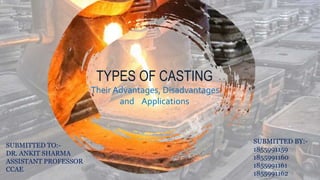
Types of Casting Process
- 1. TYPES OF CASTING Their Advantages, Disadvantages and Applications SUBMITTED TO:- DR. ANKIT SHARMA ASSISTANT PROFESSOR CCAE SUBMITTED BY:- 1855991159 1855991160 1855991161 1855991162
- 2. TYPES OF CASTING Casting can be of many types, some of them are: Investment casting Sand casting Die casting Centrifugal casting Plaster casting Permanent mold casting To be discussed:- Investment casting Sand casting Die casting
- 3. Investment casting is a centuries-old casting process also known as lost- wax casting. It involves coating a wax mold with a liquid material. As the wax heats up, it begins to melt off. Molten metal is then poured into the mold's cavity, essentially replacing the cavity's wax with metal. INVESTMENT CASTING
- 5. It is able to deliver close dimensional tolerances. Both ferrous and non-ferrous metals can be casted using investment casting. It delivers a good as-cast finish. With investment casting, complex shapes, intricate core sections, finer details and thinner walls are possible. It offers a flexibility in design and is a useful process for casting alloys that are difficult to machine. Advantages
- 6. Investment casting has a higher cost associated with it. When compared to other types of casting processes, investment casting needs a longer product-cycle time. There is a limitation on the size of parts that can be casted. Disadvantages
- 7. Applications Investment casting is used in the aerospace and power generation industries to produce turbine blades with complex shapes or cooling systems Investment casting is also widely used by firearms manufacturers to fabricate firearm receivers, triggers, hammers, and other precision parts at low cost. Other industries that use standard investment-cast parts include military, aerospace, medical, jewellery, airline, automotive and golf clubs especially since the start of 3D printing technology.
- 8. Sand Casting Sand casting, also known as sand molded casting, is a metal casting process characterized by using sand as the mold material. The term "sand casting" can also refer to an object produced via the sand casting process. Sand castings are produced in specialized factories called foundries. Over 60% of all metal castings are produced via sand casting process.
- 9. Sand Casting
- 10. Advantages This is the least expensive process when producing small quantities (normally less than 100) and also boasts with the least expensive tooling. With sand casting, manufacturers are able to cast very large parts. Both ferrous and non-ferrous metals can be casted using this process. A low post-casting tooling cost.
- 11. Sand casting's dimensional accuracy is less than that delivered by other processes. This process requires large tolerances. The surface finish for ferrous casts delivered by this process usually exceeds 125 RMS. Castings produced with this proceed usually exceeds the calculated weight. Disadvantages
- 12. Advantages Sand casting is used for a variety of applications to produce a wide range of parts including: air compressor pistons bearings blowers & impellers bushings cams electronic equipment engine crankcases engine oil pans fittings flywheel castings truck chassis parts valves Applications gas and oil tanks gears hardware low-pressure valves machine parts mining machine parts oil pans printing press pump bodies pump pistons screw nuts trailer parts worm gears
- 13. Die Casting Die casting is a metal casting process that is characterized by forcing molten metal under high pressure into a mold cavity. The mold cavity is created using two hardened tool steel dies which have been machined into shape and work similarly to an injection mold during the process.
- 14. Die Casting
- 15. Advantages Die casting is able to deliver parts that has a good dimensional tolerance. Parts produced using die casting require a minimal amount of post machining. It is a cost effective process when used for a high volume production run. This process is suitable for metals with a relatively low melting point, such as aluminium, lead, magnesium, zinc and some copper alloys.
- 16. This process is only an economically sound option for a large production quantity, as the tooling costs for die casting are expensive. In this process, it is difficult to guarantee minimum mechanical properties and is thus do not function as structural parts. This process is also not recommended for hydrostatic pressure applications. There is a limit on the size of parts that can be casted. It is a suitable process for castings of about up to 75 pounds. Disadvantages
- 17. Applications Die-casting is the largest casting technique that is used to manufacture consumer, commercial and industrial products like automobiles, toys, parts of sink faucet, connector housing, gears, etc.